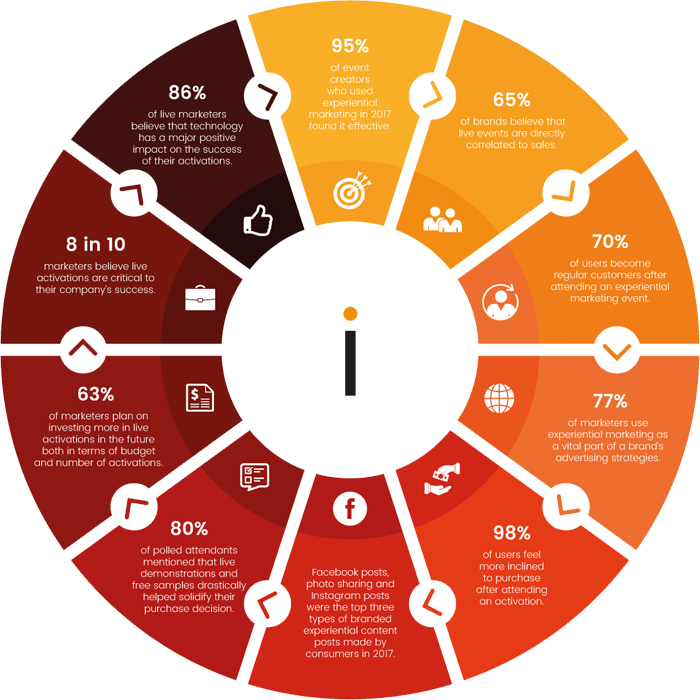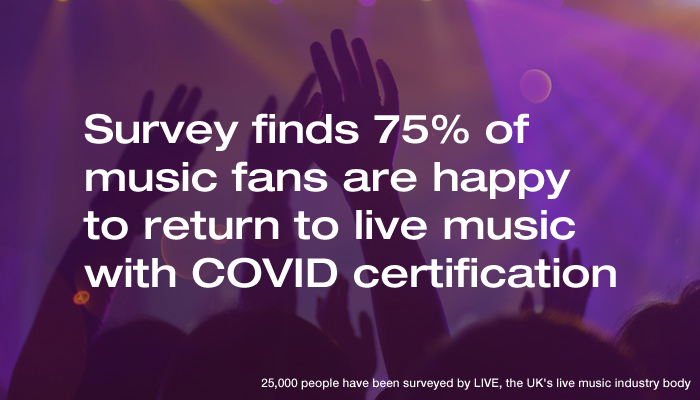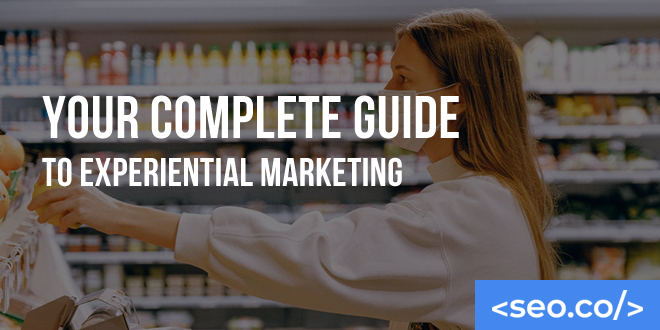Effective marketing doesn’t merely involve following the same set of “expert tips” year after year.
True, some marketing best practices are constants, but generally, a smart marketer is a marketer who adjusts their strategies based on new trends and changing customer behaviors.
For example, in recent years, many companies have begun launching experiential marketing campaigns to a much greater degree than ever before. Regardless of your industry, you should strongly consider doing the same.
You just need to know how to get started. This overview will help. It explains what experiential marketing is, why it’s a valuable component of a marketing strategy, and what types of experiences you might offer your customers.
Table of Contents
Experiential Marketing: What You Need to Know

Experiential marketing is exactly what it sounds like: marketing that involves promoting a brand through experiences.
These experiences are often live events. For example, a brand might organize a music festival as part of an experiential marketing strategy.
However, experiential marketing “content” doesn’t exclusively need to consist of live events. Virtual events can also qualify as experiential marketing. After all, brands didn’t universally abandon their experiential marketing campaigns during the Covid-19 pandemic, when organizing live events with large numbers of attendees was essentially impossible. They may have simply modified their approaches. Additionally, virtual events can reach far more potential customers than events that can only involve a limited number of attendees, most of whom will likely need to live relatively close to the event venue to participate.
Why You Need an Experiential Marketing Strategy
Why should your brand promote itself via experiential marketers when you’re already investing vast resources into other types of marketing? The following are just a few key reasons:
Catering to customer behavior

Again, while the Covid-19 pandemic did prevent most of us from attending live events in 2020, in general, interest in live events is on the rise. Harris Group research indicates that most Millennials prioritize spending money on live experiences over products. Recent surveys also confirm that 75% of live music fans would gladly attend concerts again in the wake of the pandemic as long as a means of confirming that attendees aren’t ill before entering a venue is in place.
Being stuck inside for a year has been particularly unpleasant for those who enjoy concerts, museum visits, and other experiences that don’t involve binging The Office for the third time in a month. A large portion of your potential customer base was already growing increasingly interested in live events before the pandemic. In its wake, they’ll likely be eager to return to such events. You can take advantage of that eagerness by developing an experiential marketing strategy now.
Getting free marketing content
When developing ideas for events you might organize as part of an experiential marketing campaign, make a point of constantly asking yourself how you can make the events “shareworthy.”
Again, although virtual events can be part of an experiential campaign, it’s still wise to host live events as well. Of course, only so many people can attend such events.
You might thus wonder why you should invest time and money organizing an event that only a relatively small part of your customer base can actually engage with. This is understandable.
However, you need to remember that we live in an age when people will share a picture of their dinner with thousands of Instagram followers if they think it looks even somewhat impressive. True, not very many people can directly engage with experiential marketing content when it takes the form of a live event, but if they share pictures and posts about the event on social media, others will still engage with it in an indirect way.
This highlights one of the key benefits of experiential marketing: When event attendees post about your event on social media, they’re essentially generating free marketing content for your brand. This makes experiential marketing much more cost-effective than it might initially seem.
Once more, you just need to make sure you’ve given event attendees a genuine reason to post about it in a way that ensures those who see such posts will associate them with your brand.
For example, an outdoor music festival is already somewhat shareworthy by default. It’s definitely not uncommon for music festival attendees to post pictures of their favorite performances on social media.
However, those pictures might not necessarily have anything to do with your brand. A marketer could improve brand association by choosing to include their brand’s name in the name of the festival, creating a branded hashtag, asking that performers wear branded clothing, and extensively decorating the venue with an emphasis on the brand’s iconography.
Those are just a few experiential marketing examples. The main point to remember is that experiential marketing can give customers a way to naturally create free marketing content for your brand. Strive to take full advantage of this benefit when developing a strategy.
Immersing customers in your brand
A customer or lead won’t necessarily develop a strong connection with your brand if they only engage with it for a short period of time. For example, a witty Twitter post may make a brief impression on a customer, but that might not be enough for them to connect with your brand in a way that fuels loyalty and long-term engagement.
That’s not to say you should abandon social media marketing. However, you should consider how experiential marketing can amplify the short-term effects of your other marketing content.
When a lead has an experience or attends an event you’ve organized, it gives you an opportunity to immerse them in your brand for hours (or even days) at a time. This level of immersion can result in far greater brand engagement marketing experience than is possible with other marketing strategies.
Demonstrating products
Just about any company can benefit from implementing a winning experiential marketing strategy. However, experiential marketing is particularly useful for companies whose products or services need to be demonstrated in order for customers to understand their value.
Very often, branded experiential marketing events involve giving attendees the chance to see products in action. Some events even allow attendees to use products.
Keep that in mind when developing your experiential marketing ideas. If you could attract more customers by clearly showing leads how your products or services work, make a point of doing so during branded events or experiences.
Generating positive brand association
Want to know a smart way to improve your overall approach to marketing? When developing campaigns and content, think like a teenager trying to impress a date.
No, that doesn’t mean you should inhale breath mints, get a new haircut, and read dating blogs religiously. It means you should consider how potential customers will associate your brand with an experience they have in connection with it.
Many young people intuitively know it’s a good idea to plan a first date that involves a fun and memorable activity, like attending an amusement park or seeing a funny movie. They may not realize it, but they’re simply taking advantage of a well-researched psychological principle when doing so. Researchers have found that when our early experiences with a person involve memorable emotions, such as excitement, we often subconsciously associate that person with those feelings. For example, if you go on a first date with someone at an amusement park, without knowing it, you may later think of them as a fun person (even if they’re not).
This principle can also explain why experiential marketing is so effective. When you invite potential customers to attend a memorable event, they’ll mentally link your brand with the feelings they had during the event. This is yet another reason experiential marketing tends to yield major brand loyalty.
Experiential Marketing Ideas to Keep in Mind
Many factors, from your budget to your brand, will influence the types of events and experiences you offer your customers when implementing an experiential marketing strategy. However, the following general examples should help you begin developing ideas. Types of experiential marketing “content” include:
Art exhibits
Branded events definitely play a valuable role in experiential marketing strategies. However, they have some key limitations. For example, a branded event can only last a day or so.
That’s why you might want to also develop experiential marketing ideas that have longer lifespans. For example, many brands place unique artwork or exhibits (many of which involve some sort of interactive element) in major cities. They’re often able to leave these exhibits up for weeks or even months at a time.
An exhibit or piece of unique art also doesn’t necessarily have to have a clear link to a business’ products or services to be effective. For example, in a German subway stop, Volkswagen installed a set of stairs that resembled a piano. When travelers walked on the stairs, the steps “played” notes.
This provided commuters with an interesting branded experience. Did it have anything to do with cars? Not at all. But, it was an experience unique enough that most would remember having it. Theoretically, that means they would also think of Volkswagen’s brand when recalling the experience. Thus, this marketing strategy likely achieved its intended purpose: cultivating brand awareness.
Compared to traditional marketing channels, experiential can create brand awareness like no other marketing channel.
Virtual reality experiences
Planning branded events can be difficult if you’re on a tight budget. Additionally, depending on the nature of your products and services, organizing the types of events that might appeal to your customers might not seem feasible.
There’s another option to keep in mind in these circumstances: virtual reality.
Consider how North Face used VR to immerse customers in a unique branded experience. The company’s marketers created branded 360-degree videos that allowed customers to “visit” such spots as Yosemite National Park in VR without actually having to travel. Some car companies have also designed VR “test drive” videos.
Consider how your brand can use VR to offer customers memorable experiences. Those who already own VR headsets can access your VR experiential marketing content at home. Those who don’t can potentially engage with this content at your stores or during a branded event if you keep a few VR headsets on hand.
Pop-ups
Again, experiential marketing campaigns don’t need to be as costly as you may assume. One reason is simply because the experiences and events you plan can bring in revenue on their own.
To return to an example we’ve covered throughout this overview, if you were to plan a concert or similar event, you could sell tickets, ensuring the branded event serves as a form of marketing content while also potentially paying for itself.
Setting up a pop-up store is another way to make experiential marketing not just affordable, but even lucrative. A pop-up store is a small temporary location that may be unique from your other locations in some way. For example, some brands partner with media companies to design pop-up stores or restaurants that are based on popular movies or TV shows. This helps them capture the attention of customers more easily than they otherwise would.
Your pop-up location doesn’t need to be based on a movie or show. That’s just one example. However, it should provide visitors with a unique experience in order to qualify as a strong example of experiential marketing in action.
Games
Remember, if you can generate experiential marketing content that customers can engage with for a long period of time or engage with on a consistent basis, you should.
That’s why brands often develop branded mobile games or apps. A mobile game (if it’s any good!) will naturally provide a user with a pleasant experience. It can also be something they return to time and time again, resulting in frequent and lasting brand engagement.
Conclusion
Just remember that these are only a few examples. The key when planning experiential marketing campaigns is to develop ideas that are unique from others. This may require investing some time and money, but if you plan thoroughly, in the long run, an experiential marketing campaign can yield major benefits.



